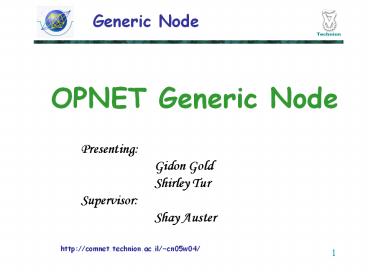OPNET Generic Node - PowerPoint PPT Presentation
1 / 31
Title:
OPNET Generic Node
Description:
DESIGN AND APPLY A GENERIC NODE THAT WILL BE USED BY FUTURE DESIGNERS TO ... Auto Assign slots. Auto Assign total ... Collision is detected and the colliding ... – PowerPoint PPT presentation
Number of Views:215
Avg rating:3.0/5.0
Title: OPNET Generic Node
1
OPNET Generic Node
- Presenting
- Gidon Gold
- Shirley Tur
- Supervisor
- Shay Auster
http//comnet.technion.ac.il/cn05w04/
2
Abstract
- DESIGN AND APPLY A GENERIC NODE THAT WILL BE USED
BY FUTURE DESIGNERS TO TEST THEIR WORK
3
Known problem
- designers working with OPNET on layers 2 (Data
Link Layer) and higher on the OSI Reference Model
have to model the MAC and Physical layers to test
their work.
Solution
Design and model an OPNET generic node that can
be configured to use different MAC and Physical
layers.
When an engineer will want to test his work he
will use this node and choose the MAC and
Physical layers that suit him.
4
GENERAL DESIGN - Node Model
- Application
- GENERIC MAC
- Physical
5
GENERAL DESIGN - Node Attributes
- MAC protocol
- Packet Generate
- TDMA Attribute
- CSMA Attributes
6
GENERAL DESIGN - Simulation Attributes
- Physical
- Bit Error Rate
- Data Rate
- Max Block Size
- TDMA
- Number of slots
- Slot Length
7
Process Design - Source
- Generates packets
- Packet size and generation interleave as set
in the node attribute - Packet destination is randomly chosen (uniform
1,stations)
8
Process Design - Packet format
- A general MAC packet format that could be later
adapted to more specific ones. - Fields
- destination (32 bit)
- Payload
9
Process Design - Sink
- Collects results and destroys received packets
- End 2 End delay is calculated
- E2E current time creation time
10
Process Design - Generic MAC
Generic MAC
- ALOHA
- TDMA
- CSMA_CA
Child processes
11
Process Design - Generic MAC
Child process invocation
12
Process Design - ALOHA MAC
- simple if you have Packet to send, "just do it"
- if Packet suffers collision, will try resending
later
13
Process Design - ALOHA MAC
14
Process Design - TDMA MAC
15
Process Design - TDMA MAC
- Auto Assign slots
- Auto Assign total number of slots
- If a manually assigned slot is bigger then the
number of total slots a warning is generated
and two stations will be allowed to transmit in
the same slot
16
Process Design - CSMA MAC
- RTS - Request To Send
- CTS - Confirm To Send
- SIFS - Short Interface Space
17
Process Design - CSMA MAC
18
Process Design Adding a new MAC protocol
Generic MAC Model Attributes
MAC Protocol Attribute Properties
19
Process Design - Physical
- Collision is detected and the colliding packets
are marked - Total packet Error Rate is calculated
- If PACKET_BER lt dist_uniform (0,1) Then packet
is dropped
20
Statistics and Results
- Simulation scenario
- all nodes
- packet interval uniform 0,5
- packet size uniform 16, 2048
- max block size 1536
21
Statistics and Results End 2 End Delay
ALOHA
TDMA
CSMA
0.51 sec
900 sec
0.62 sec
0.58 sec
Channel access delay
Cycle 600 sec
22
Statistics and Results CSMA channel access delay
0.07 sec
23
Statistics and Results Queue Size
TDMA
CSMA
24
Statistics and Results Message Completion Rate
ALOHA NO BER
Packets Sent 8200
Packets Lost to Collision 5500
Packets Too Big To Be Sent 2000
Packets Received 700
MCR 8.5
25
Statistics and Results Message Completion Rate
TDMA NO BER
Packets Sent 8200
Packets received 6100
Packets Too Big To Be Sent 2100
MCR 74
26
Statistics and Results Message Completion Rate
CSMA NO BER
Packets Sent 8200
Packets Lost to Collision 5300
Packets Too Big To Be Sent 2000
Packets Received 900
Success Rate 10.9
27
Statistics and Results Message Completion Rate
ALOHA with BER 0.02
Packets Sent 8200
Packets Lost to Collision 5400
Packets Too Big To Be Sent 2000
Packets Lost to BER 750
Packets Received 150
Success Rate 1.8
28
Statistics and Results Message Completion Rate
TDMA with BER 0.02
Packets Sent 8200
Packets Lost to BER 5700
Packets Too Big To Be Sent 2100
Packets Received 400
MCR 4.8
29
Statistics and Results Message Completion Rate
CSMA with BER 0.02
Packets Sent 8200
Packets Lost to Collision 5300
Packets Too Big To Be Sent 2000
Packets Lost to BER 710
Packets Received 190
MCR 2.3
30
Statistics and Results Point of Interest
- MCR with BER / MCR without BER
- Aloha 0.211
- TDMA 0.064
- CSMA 0.211
- Packet Success
- (Sent ToBig)(BER) n (Sent
ToBig)(collision) - TDMA lost no packets to collision ? much more
vulnerable to BER influence
31
Project Goals
- Learning OPNET modeling environment v
- Learning Different MAC protocols v
- Implementing a GENERIC node v
- Easy to add MAC protocol interface v
The End !































